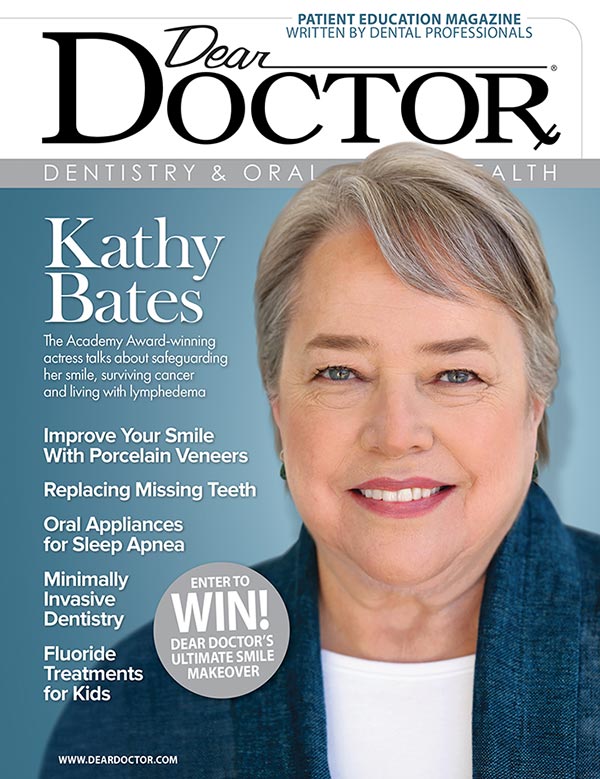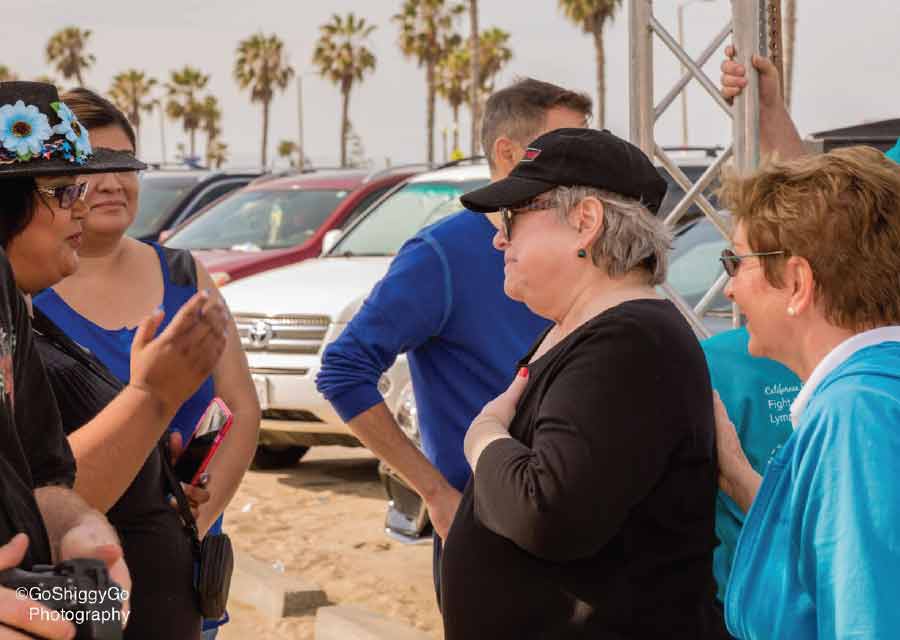Kathy Bates
The Academy Award-winning actress talks about safeguarding her smile, surviving cancer and living with lymphedema
When Kathy Bates won her first major screen acting award at age 42 — a best actress Oscar for her leading role in the Stephen King thriller Misery — she was fulfilling a prophecy of sorts.
"I was told early on that because of my physique and my look that I'd probably blossom more in my middle age, which has certainly been true," the veteran performer told Dear Doctor magazine during a recent interview. "I'm what's considered a character actor. In a way that's been lucky for me because I've seen a lot of the Hollywood glamour girls fade after 40."

With a career spanning five decades (so far), fading away is not something Kathy shows any signs of doing. Before achieving stardom in the Rob Reiner-directed Misery in 1990, she appeared frequently on stage, winning critical acclaim for roles in both on- and off-Broadway productions. Since then, Kathy has appeared in Hollywood blockbusters such as Titanic, About Schmidt and The Blind Side, and created an impressive body of TV work.
Today she continues to perform at the top of her game, most recently earning an Emmy for her work in the television series American Horror Story. And even if she doesn't describe herself as a "Hollywood glamour girl," she certainly does have a beautiful Hollywood smile — thanks, in part, to orthodontic treatment she had in her fifties.
"I've always had good teeth, but it seemed to me as I was getting older that they weren't looking as good," Kathy explained. "I noticed that my teeth were moving around."
If that sounds like a line from one of Kathy's spookier television roles, it isn't. Teeth really can shift position over time, and they frequently do. While most people think of teeth as being solidly encased in bone, they are actually attached to the jawbone by a stretchy network of fibers called the periodontal ligament. This is what allows them to move ever so slightly in response to the normal stresses of biting and chewing. It can also cause them to drift out of alignment.
Fortunately, this mobility has an upside: Specially trained dentists can use orthodontic appliances such as braces to apply light, controlled forces that guide teeth into a better alignment. While many people associate orthodontics with teenagers, there's no age limit for treatment — provided your teeth are healthy, as Kathy's are.
Like many adults undergoing orthodontic treatment, Kathy opted for Invisalign® clear aligners — a discreet form of orthodontic treatment.
"When I heard about Invisalign, I thought, hmm, maybe this is better than getting braces, so I'll give it a try," she said. "And I'm really glad I did."
After any type of orthodontic treatment, a retainer is almost always worn to keep teeth in their new and improved alignment. Kathy said she is very conscientious about wearing hers.
"I wear a retainer every night," she said. "I got lazy about it once and then it was very difficult to put the retainer back in. So I was aware that the teeth really do move."
To keep that straight smile looking bright, Kathy uses a teeth-whitening kit provided by her dentist. And she likes using a travel-sized electric toothbrush, also recommended by her dentist.
"It's a pink one…that's very cool," she said, adding that she makes sure to brush for a full two minutes, as recommended by the American Dental Association.
Kathy also recognizes the importance of regular professional cleanings at the dental office.
"I go about every four months," she said. "I'm pretty careful about it. My father had really good teeth. My mother had terrible teeth that fell out slowly over the years. I'm not sure which side of the genetic family I'm on, so I'm very careful about keeping my teeth clean."
Dental problems aren't the only health issue evident on her mother's side: Several close relatives, including her mother, have had breast cancer; about four years ago, Kathy herself was diagnosed with the disease. She had a double mastectomy, during which 19 lymph nodes were also removed.
"The lymphatic system is the highway for cancer cells to travel through the body and metastasize, so [the surgeon] was erring on the side of being cautious," Kathy explained.
Unfortunately, the removal of those nodes caused lymphedema — a condition in which lymph, a protein-rich fluid that brings white blood cells throughout the body to fight infection, seeps into places it doesn't belong. This can cause painful swelling and even disfigurement. Kathy's lymphedema is in her arms.
"When I was in the hospital recovering, I could feel strange things in my hands, it just didn't feel right to me," she recalled. "Sure enough, my arm began to swell." Kathy must now wear compression sleeves almost constantly to control the swelling. She also has periodic massage treatments to help move the fluid out of the tissues of her arms.
While lymphedema affects over 30% of breast cancer survivors, Kathy said, not many doctors are well-versed in the condition — even though it affects millions of people. "It took a while to find someone who could treat me," she said. Her quest for compassionate, knowledgeable lymphedema care eventually led her to Emily Iker, a California doctor who specializes in the disease.
"When I got to her, I was extremely angry," Kathy said. "I felt betrayed by life, by anybody that crossed my path. After losing my breasts and then having this as a souvenir that I didn't want, I felt that I didn't want to be in this body anymore."
Dr. Iker helped Kathy come to terms with the reality of her situation.
"She said to me, 'You have your whole life ahead of you. Have a glass of champagne…Put all of that behind you and now begin to move forward.' Some doctors just have a way of being human and connecting with you in a way that makes you feel healed already, before they've even laid a hand on you, and she was one of those," Kathy said.
Dr. Iker also put her in touch with an organization known as LE&RN, which stands for Lymphatic Education & Research Network. That's when she realized she wasn't alone.

"Ten million Americans suffer from lymphedema and lymphatic diseases. That's more than muscular dystrophy, ALS, MS, AIDS and Parkinson's — combined," said Kathy. "And yet it's the silent epidemic. No one talks about it. No one knows about it. Doctors are rarely taught in medical school — maybe they spend an hour and a half, two hours even discussing lymphedema. As a result, patients go undiagnosed, which means that the condition worsens over time — something that is in the beginning manageable becomes totally irreversible and expensive to treat, and it really robs you of your quality of life."
This is something Kathy knows all too well.
"I love to drive and sometimes it's just a drag, your arms get tired driving," she said. Hot weather can also make things very uncomfortable, as was the case on the set of American Horror Story in Louisiana.
"I found it difficult because my arm would swell," she recalled. "We tried to make costumes with long [sleeves] but sometimes that's just impossible so I wasn't able to wear my compression sleeves during the heat and that's uncomfortable. I do have pain when they swell. In New Orleans, I had a lot of pain."

Since joining LE&RN and becoming the group's celebrity spokesperson two years ago, Kathy has attended conferences and learned a lot about the lymphatic system. For example, she discovered that problems of the lymphatic system can be congenital, affecting children who have never had cancer. She was particularly moved by a 7-year-old named Emma Detlefsen, who was born with lymphedema in her legs and feet — yet participated in a LE&RN fundraising walk across the Brooklyn Bridge.
"She said, 'If I can do something hard for me, like walk [across] the Brooklyn Bridge, maybe a smart doctor can do something hard for him and find a cure for this in my lifetime.' These are the people I'm finding behind the numbers," Kathy said.
It was stories like this that prompted Kathy to become a spokesperson for the organization. She said that while other celebrities with lymphedema had turned down LE&RN's request to help give the disease a higher profile, she did not hesitate.
"I've spent over 50 years of my life as an actor, and that means I spend 90 percent of my time either trying to figure out how to be other people or spending time being other people, and it's an imaginary world," she said. "This was an opportunity for me to do something real — to do something in the real world that would help other people."
While becoming an advocate for people with lymphedema may not be a role she would have chosen, it's one she's approaching with characteristic dedication. And if her past is any guide, Kathy Bates may one day celebrate success against this disease.